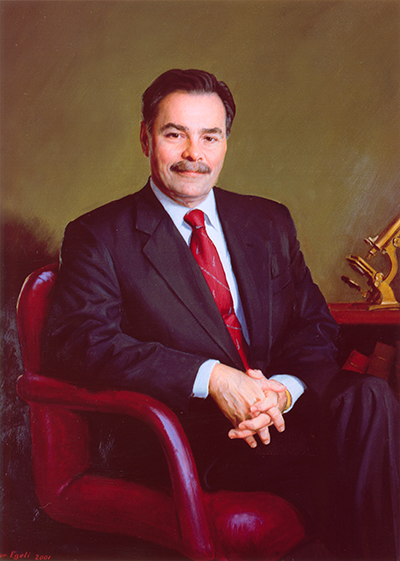Alfred P. Sanfilippo

Alfred P. Sanfilippo
- Artist:
- Peter E. Egeli
- Date:
- 2001
- Medium:
- Oil on canvas
- Dimensions:
- 43 x 33 in.
Alfred P. Sanfilippo
1949-
Sanfilippo, a director of pathology at Johns Hopkins, was born in Racine, Wisconsin. He received his bachelor’s and master’s degrees in physics from the University of Pennsylvania. He then attended Duke University, earning a Ph.D. in immunology in 1975 and a medical degree in 1976. After an internship and residency in anatomic and clinical pathology at Duke, Sanfilippo joined the Duke faculty in 1979 as assistant professor of pathology. In 1989, he was named professor of pathology and in 1990, he became professor of both experimental surgery and immunology.
In 1993, Sanfilippo moved to Johns Hopkins to become Baxley Professor and director of the department of pathology and pathologist-in-chief of The Johns Hopkins Hospital. He led the formation of the Johns Hopkins Comprehensive Transplant Center, serving as its first director of research.
In 2000, Sanfilippo became senior vice president and executive dean for health sciences at Ohio State University and CEO of the Ohio State University Medical Center. He moved to Emory University in 2007 to become executive vice president for health affairs, a position he held until 2010. He continued on the faculty at Emory as professor of pathology at the school of medicine, professor of health policy and management at the Rollins School of Public Health, and professor of business administration for the Goizueta Business School. Sanfilippo is also director of the Emory-Georgia Tech Healthcare Innovation Program.
A former president of the American Society of Transplant Physicians, Sanfilippo’s research interests include the mechanisms of rejection and tolerance in transplantation, especially in cross-species transplants. More recently, he has focused on the application of informatics to enhance the quality of health care delivery at the individual and population levels, and enhancement of organizational performance and culture.
Sanfilippo has served on the editorial board of thirteen professional journals, and as president of seven academic and professional organizations. He has published over 250 articles, was awarded three patents, and has received over $30 million in grant funding to support his research.
"*" indicates required fields
